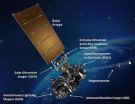(Press-News.org) The solar array that will provide power to NOAA's GOES-R satellite has been tested, approved and shipped to a facility where it will be incorporated on the spacecraft. The five sections of the solar array come together as one to resemble a giant black wing.
On May 13, 2014, the GOES-R satellite solar array panels were successful deployed in a Lockheed Martin clean room in Sunnyvale, California. The completed solar array was then delivered to Lockheed Martin's facility near Denver.
"The GOES-R solar array generates more than 4,000 watts of power, twice as much as that of the previous generation of GOES satellites, in order to operate the larger and more capable instruments carried by GOES-R," said Pam Sullivan, GOES-R flight project manager at NASA's Goddard Space Flight Center in Greenbelt, Maryland.
The GOES-R spacecraft uses a photovoltaic solar array to derive electricity from sunlight. Photovoltaics is a method that uses semiconductors to convert solar radiation into direct current electricity.
The solar array is comprised of five separate solar panels that are folded up at launch. After the satellite is released by the launch vehicle, the solar panels are deployed into a single solar array wing that rotates once per day on orbit to continuously point the solar array photovoltaic cells towards the sun.
The solar array provides a stable platform that tracks the seasonal and daily movement of the sun relative to the spacecraft. It will power all of the instruments, including the computers, data processors, attitude control sensors and actuators, and telecommunications equipment.
The instruments include the Extreme Ultraviolet and X-ray Irradiance Sensors (EXIS), the Magnetometer, the Space Environment In-Situ Suite (SEISS), Solar Ultraviolet Imager (SUVI), the Advanced Baseline Imager (ABI), Geostationary Lightning Mapper (GLM), and Unique Payload Services (UPS). The UPS suite consists of transponder payloads providing communications relay services in addition to the primary GOES mission data. The UPS suite consists of the Data Collection System (DCS), the High Rate information Transmission / Emergency Managers Weather Information Network (HRIT/EMWIN), GOES-R Rebroadcast (GRB), and the Search and Rescue Satellite Aided Tracking (SARSAT) System.
The GOES-R, or Geostationary Operational Environmental Satellite – R Series, advanced spacecraft and instrument technology will result in more timely and accurate weather forecasts. It will improve support for the detection and observations of meteorological phenomena and directly enhance public safety, protection of property, and ultimately, economic health and development.
GOES-R will be more advanced than NOAA's current GOES fleet. The satellites are expected to more than double the clarity of today's GOES imagery and provide more atmospheric observations than current capabilities with more frequent images.
NOAA, the National Oceanic and Atmospheric Administration, manages the GOES-R Series Program through an integrated NOAA-NASA program office, staffed with personnel from NOAA and NASA, and co-located at NASA's Goddard Space Flight Center in Greenbelt, Maryland.
INFORMATION:
NOAA GOES-R satellite black wing ready for flight
2014-06-24
ELSE PRESS RELEASES FROM THIS DATE:
Combo tumor imaging can distinguish malignant & benign breast tumors, help avoid biopsies
2014-06-24
PHILADELPHIA — Imaging breast tumors using four approaches together can better distinguish malignant breast tumors from those that are benign, compared with imaging using fewer approaches, and this may help avoid repeat breast biopsies, according to a study published in Clinical Cancer Research, a journal of the American Association for Cancer Research.
"By assessing many functional processes involved in cancer development, a multiparameter PET-MRI of the breast allows for a better differentiation of benign and malignant breast tumors than currently used DCE-MRI alone. ...
What millennials want
2014-06-24
Millennials, the generation after Generation X, born in the 1980s and 1990s, form their own demographic group, with their own unique tastes. According to a June 23rd panel at the 2014 Institute of Food Technologists (IFT) Annual Meeting & Food Expo® in New Orleans, industry must keep up with Millennials high-speed, digital-age expectations, if they're going to gain and keep them as customers.
"Millennials are food savvy and tech savvy," said Heidi Curry, Senior Manager Baker, Global Research and Development with Dunkin' Brands. "In addition, they're socially and environmentally ...
BMI measurement may be missing 25 percent of children who could be considered obese
2014-06-24
ROCHESTER, Minn. — Physicians using body mass index (BMI) to diagnose children as obese may be missing 25 percent of kids who have excess body fat despite a normal BMI, which can be a serious concern for long-term health, according to a Mayo Clinic study published online today in Pediatric Obesity.
The researchers found that BMI has high specificity in identifying pediatric obesity, meaning BMI accurately identifies children who are obese, but has a moderate sensitivity, meaning the BMI tool misses children who actually should be considered obese, according to the percent ...
Study suggests prayer can build unity in diverse organizations
2014-06-24
WASHINGTON, DC, June 24, 2014 — As the United States grows more diverse than ever, organizations from Fortune 500 companies to political parties are scrambling to keep pace. But in doing so, they face the challenge of uniting people from very different backgrounds in a single purpose.
A new study led by a University of Connecticut sociologist suggests that if they want to succeed, they could learn a lot from how an unlikely practice — prayer — is used in one set of diverse organizations.
Specifically, the study finds that interfaith group prayer serves as a "bridging ...
UF part of research team that finds equine influenza virus in camels
2014-06-24
GAINESVILLE, Fla. --- University of Florida researchers have found evidence that an influenza A virus can jump from horses to camels – and humans could be next.
The One Health Center of Excellence for Research and Training in UF's Emerging Pathogens Institute, in collaboration with U.S. and Mongolian institutions, has identified the first known case of an equine influenza virus in camels. Their findings will be published in the December issue of Emerging Infectious Diseases, but an ahead of print version of the report is available here:
http://wwwnc.cdc.gov/eid/article/20/12/14-0435_article
"Over ...
Prior drug use is the greatest predictor of ecstasy use US high school seniors
2014-06-24
Ecstasy, also known by its chemical abbreviation MDMA, is an illicit drug that is commonly taken at nightclubs and dance parties. Ecstasy's street names include: "Molly" (U.S.), "Mandy" (U.K.), "E," and "X." Although not limited to nightlife scenes, ecstasy is popular at dance parties, as it tends to enhance the party experience (e.g., perceptions of lights and music, nightlife socialization).
A study just published in the journal Substance Use & Misuse by researchers affiliated with New York University's Center for Drug Use and HIV Research (CDUHR), examined a national ...
New study uses blizzard to measure wind turbine airflow
2014-06-24
A first-of-its-kind study by researchers at the University of Minnesota (UMN) using snow during a Minnesota blizzard is giving researchers new insight into the airflow around large wind turbines. This research is essential to improving wind energy efficiency, especially in wind farms where airflows from many large wind turbines interact with each other.
The study by researchers at the UMN College of Science and Engineering's St. Anthony Falls Lab was published today in Nature Communications, a major scientific journal.
Wind energy is one of the fastest-growing renewable ...
Consumers looking for reduced sugar and salt in food products more than low- and no-fat
2014-06-24
More than 50 percent of consumers are interested in products with reduced levels of salt and sugar, and yet new products in the United States are more likely to tout low- or no-fat attributes, according to a June 23 panel discussion at the 2014 Institute of Food Technologists (IFT) Annual Meeting & Food Expo® in New Orleans.
In recent research, just 25 percent of consumers claimed to be dieting, yet more than 70 percent said they want to lose weight.
"Consumers know they need to take care of their health," said Lynn Dornblaser, director, innovation & insight, Mintel ...
From deep sea to deep space
2014-06-24
How do you feed a six-person crew on a three-year mission to Mars?
Food scientists are working on this and other challenges related to creating and optimizing food for astronauts, soldiers, pilots and other individuals working and living in extreme environments, according to a June 23 panel discussion at the 2014 Institute of Food Technologists (IFT) Annual Meeting & Food Expo® in New Orleans.
The constraints often are similar whether the food is created for the desert, mountains, deep sea or space – it needs to be nutritious, palatable, light-weight, easy to store ...
Energy drinks raise new questions about caffeine's safety
2014-06-24
Caffeine, which was extensively researched for possible links to birth defects in animals and cardiovascular disease in humans over 30 years ago and then exonerated, has become the focus of renewed concerns as caffeine-containing energy drinks have surged in popularity. However, according to a June 23rd panel discussion at the 2014 Institute of Food Technologists (IFT) Annual Meeting & Food Expo® in New Orleans, a rich database of health evidence exists confirming the safety of caffeine for consumers at current levels of exposure. What isn't known, however, is how caffeine ...

